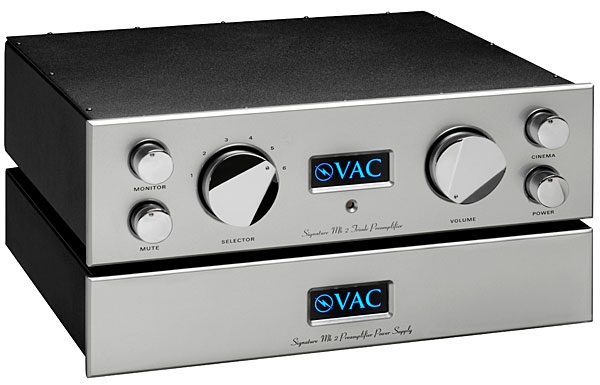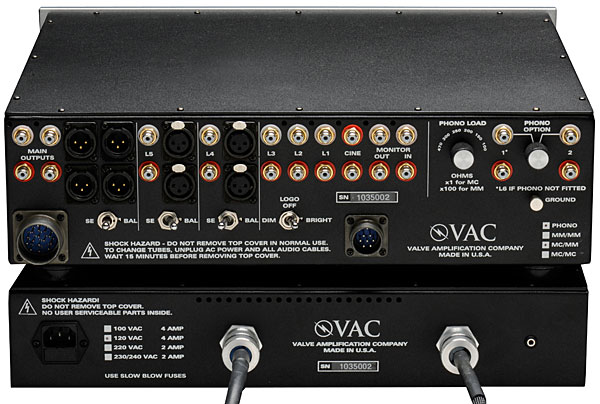| Columns Retired Columns & Blogs |
Where is RR going?

A saga began. VAC is a small company, but the demand for its products is high, and backorders caused several delays. VAC was understandably reluctant to send a sample to a reviewer and thus make a customer who'd already paid for a unit wait even longer. Then the company's founder, Kevin Hayes, called with some good news. VAC would be introducing an upgraded version of the Signature Mk IIa, the Signature SE, which would include technology trickled down from VAC's flagship preamplifier, the Statement Line ($75,000). If I could wait just a bit longer, I could have an early-production Signature SE.
Well, of course! I requested a sample of the Signature SE ($19,500) that included the optional MC/MM phono stage ($6500): total retail price, $26,000. Some two years after my initial request, a Signature SE finally arrived. I wondered if it would prove worth the wait.
Designing
According to Kevin Hayes, the Signature SE line stage is, in effect, a small, zero-feedback, class-A, triode power amplifier with a step-down output transformer. He claims that this makes its output very stable and nonreactive and, as such, resistant to the stray interactions of the power amplifier and source component that can occur when various types of feedback are employed. The line-stage circuitry is hand-wired from point to point. The Signature SE controls the volume level using high-grade potentiometers; Hayes concluded from his testing that chip controls and stepped attenuators are sonically inferior.
The optional phono stage is no mere afterthought. It uses six 12AX7 triode tubes and, like the line stage, no feedback. It has its own power transformer and filter circuit, and has moving-coil and moving-magnet inputs, each with variable loading. The MC input is routed to a step-up transformer that provides another 18dB of gain before the MM stage. I'm impressed that VAC has figured out a way to incorporate a phono stage with six tubes, two transformers, and additional circuitry within the case of an existing line stage.
The Signature SE also includes the input transformers used in the Statement Line, and several other features not found in the Signature Mk IIa: improved input signal routing, enhancements of and a new layout for the phono circuit, and a new layout for the line stage.
The Signature SE has five line-level inputs, three of which can be configured for balanced or single-ended operation; and two outputs, each configurable as balanced or single-ended. If the preamp is ordered without phono stage, the phono input can serve as a sixth line input. Also featured is a Cinema Bypass input, which has fixed gain, for use with home theater systems, where control of system volume will be handled by the processor.

On the Signature SE's front panel are an input Selector, and controls for Volume, Mute, logo brightness intensity, Power, and Cinema bypass. The rugged but tiny remote control has three buttons: volume up, volume down, and mute. When I handed it to an audiophile friend, he said, "That's all you need."
The Signature SE comes with an outboard power supply. I was amazed that it ran very cool, despite the fact that it has eight tubes and only a few discreet ventilation slots.
I auditioned both the line and phono stages, using into the MC input my Koetsu Urushi cartridge, loaded at 100 ohms.
Listening
I've now auditioned quite a few expensive tubed line stages in my house, and every one has fit this pattern: flawless or nearly flawless sound, each with a unique sonic personality that would match certain listening tastes. But just as none of those preamps fell short of the others in any meaningful way, not one so outperformed the rest that I would prefer to listen to only it.
With the arrival of the VAC Signature SE, that changed. I spent many weeks listening to it, trying to describe how this preamp presented a more realistic reproduction of live music than any other preamp I'd heard in my house, but found it difficult to put into words. True, with every recording I played, the Signature SE gave a flawless performance—I could find nothing even approaching a weakness shortcoming. It produced an illusion of live musicians playing in an actual space better than any preamp I'd heard.
As I dug deeper into my music collection, I concluded that, in three critical areas, the VAC achieved a level of performance I hadn't thought possible from a tubed line stage:
1) Levels of detail resolution, ambience retrieval, air, and low-level dynamic articulation across the audioband that were nearly indistinguishable from a live performance.
It's winter. You're late for work. Your windshield is covered with nearly frozen fog and haze. You can't see. You crank up the heater and defroster, but can't wait for them to do their duty. You grab a damp rag and wipe the inside of the windshield as best you can, applying extra elbow grease to the center on the driver's side, to maximize visibility. You drive off. Your visibility is pretty good at the center, but around the periphery a foggy haze still limits your vision. You should have waited five minutes to fully warm up the car, let the defroster run full blast, then driven off with a crystal-clear windshield and full visibility.
The Signature SE's clarity, transparency, and resolution were analogous to waiting those last five minutes. By comparison, other expensive tubed line stages I've heard sound like the quick rag job. The midrange might be gorgeously transparent, but some other regions of the audioband are less tactile, less lifelike. With the Signature SE, the crystal clarity extended throughout the audioband and all areas of the soundstage with all recordings: In every case, I could hear deeper into the performance.
2) Lightning-fast articulation of transients but with no hint of sharpness, and no sense of dulling or softening at the frequency extremes.
I love percussion recordings and their sense of transient speed. But in the reproduction of a recording, I don't want any trace of sharpness or etch. Neither do I want the softened transients at the extremes of the audioband that I've heard some line stages produce in an attempt to avoid an "etched" sound. The Signature SE never approached either quality with any recording. All percussion sounded extremely fast and lifelike, with no artificial edge, nor was there ever the slightest hint of softening in any frequency region. Not surprisingly, the VAC was also unforgiving of any recording whose sound included even a bit of transient edge; there was no tube-like softening.


John Atkinson
Editor, Stereophile

Hi John - maybe this has been litigated in the past, but this one is fresh in my mind after seeing Kevin Hayes reply in the latest print issue.
Personally feel that Manufacturer comments should be appended to the online versions of reviews, especially if the reply is more substantive than a general 'thank you' and makes a valid point about the review itself.
I realize this may take extra effort, and perhaps providing comments and follow-ups might not be feasible for archival postings, but in my mind would certainly represent journalistic best practice.

Personally feel that Manufacturer comments should be appended to the online versions of reviews...
It's now included in this Web reprint of the VAC review.
John Atkinson
Editor, Stereophile

I have no connection whatsoever to VAC but had read the review as well as comment and felt appropriate.
I'm in the midst of considering some upgrades to my system and in re-reading back issue reviews have realized that many of the most informative are from Robert Reina. His voice will be missed.

Read this review several times knowing it was RR's last. In fact went back to past issues to re-read his older reviews. So long Robert J. Reina your Stereophile subscribers and Hi-Fi community miss you.

1) You mention the "pass through" for video on the VAC. How exactly would that be hooked up? If you wanted could you hook up HDMI connectors and if so how? For those of us who would like a 2 channel system in a place where video would be handy even if it isn't surround sound. 2) Speakers, as you know better than I, perform differently with different preamp/amp combinations. The difference is even more with tubes vs. transistors. Or so they say. Some "experts" say you should not use electrostats or planars with tubed equipment. True or not true? I now this is a challenge but recommending types of speakers rather than brands or models you would use with these reviewed products would be helpful to your readers. Thank you.

The level of after sales service from VAC is abysmal, I have been trying for months to get information from VAC regarding a replacement transformer for my VAC Auricle Pre. I have tried contacting them directly and through the local import agent and in all cases I have been totally ignored.
Too many boutique manufacturers fail to deliver on after sales service - if you sell a Rolls Royce product then you should have Rolls Royce service, unfortunately VAC deliver No Service which makes my VAC Auricle pre just a piece of land fill

Dear Bruce:
Ironically, this message was called to our attention just one day after your parts were dispatched via FedEx. We strive to provide excellent service for our products, and to answer within 24 working hours the several hundred e-mails we receive daily. In reviewing the communication trail with you, we see several times where replies were sent but which did not seem to get through to you, as sometimes happens due to spam filters and so forth. Communications with our importer in New Zealand worked more smoothly, and we are grateful for his assistance.
The VAC Auricle, the last of which was produced around 11 years ago (yours was exported to Australia in 2005), was our entry level preamplifier, priced under $2,500 US, and a delightful component, well worth repairing and using for decades to come. Yours is the only known case of a failed power transformer, as you have diagnosed it, and that part was not available. To serve you rather than abandon you, it was necessary to fabricate a new transformer assembly (two transformers, mu metal shielding can, etc.), and regrettably that took some time. These were dispatched via FedEx on 25 March, along with a few other parts that we think should be replaced as a preventative measure to ensure that you do not experience further problems.
We apologize for the time this took to achieve, the evident glitches in e-mails, and the frustration you have felt. There are more than 10,000 VAC manufactured audio components in the world, and we actively support them all, with the sole exception of the 23.1 CD transport of 1994 due to the unavailability of the laser assembly. Hopefully you will not require service again, but, if you do, will we do our best to improve on this experience.
Best regards,
Kevin Hayes, President, VAC